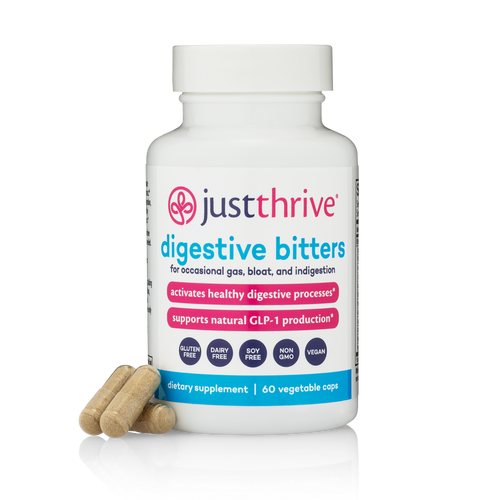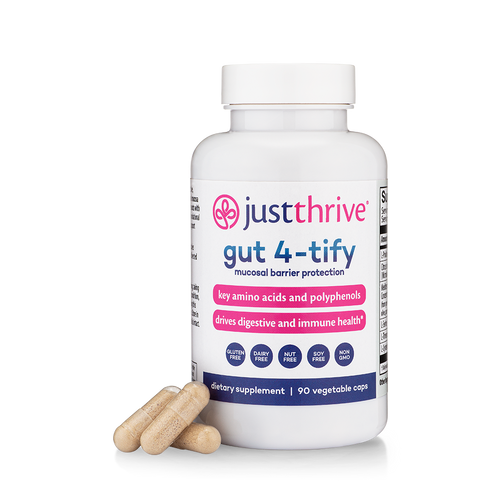And how you can stop that in its tracks
Do you look or feel older than your age? Are you plagued by wrinkles and sagging skin? Frustrated by thinning hair? Tired by 8:00 pm? Gaining weight without eating more?
Getting older is a fact of life. Premature aging isn’t.
That means if you’re feeling old before your time, you can still do something about it.
You can stop the clock, even turn it back, by going after the main cause of premature aging.
Free Radical Overload Speeds Up Aging
You may have heard a lot about free radicals on social media. After all, they’re the root cause of a lot of disease and discomfort. And a main cause of accelerated aging.[1]
But what exactly is a free radical? The medical explanation can get super detailed and scientific. Basically, though, free radicals are unstable molecules that try to become stable by stealing electrons from other molecules. Which would make those molecules unstable, leading them to steal electrons from somewhere else. This can lead to a big and damaging cascade of oxidative stress.[2]
And because your cells are made up of molecules, those unstable molecules mean unstable cells.
So what happens when free radicals destabilize your cells?
- Cellular maintenance slows to a crawl, leading to less cellular repair and replacement and more old, damaged cells.[3]
- Your supply of restorative stem cells disappears.[3]
- Your skin visibly ages, looking less dewy and vibrant and more dried up, saggy, and wrinkled.
- You face a much higher risk of developing serious chronic diseases like cancer and dementia.[4]
- Your muscles and your whole body experience chronic fatigue.[5]
- You age prematurely, declining faster than you should and feeling too old before your time.[6]

Normally, your body has a natural in-house system that fights free radicals and keeps them under control. It uses antioxidants to “donate” electrons to those unstable molecules, stopping oxidative stress.
But excessive free radicals can make it impossible for your body to keep up. The oxidative stress spirals out of control. Leaving you looking and feeling older than you are.
The Biggest Sources of Free Radicals
Your body creates free radicals every day; it’s a normal and necessary part of living. Problems crop up though when there are too many free radicals for your body to manage and keep under control.
Some free radicals come from external sources like pollution, pesticides, heavy metals, medications, and household chemicals.[7] Others come from things you ingest like alcohol, refined carbohydrates like cookies, and processed meats like pepperoni. Your body can typically combat this kind of exposure with the antioxidants you produce on your own or get from healthy whole foods.
But the biggest, most damaging source of free radicals is from leaky gut. When you have leaky gut, free radical production skyrockets.

Leaky Gut – A Leading Free Radical Producer
Your gut has a protective barrier designed to allow nutrients and healthful substances out while locking in pathogens, toxins, and other harmful compounds.[8] When the barrier holds at full strength, the bad substances stay securely trapped inside until they’re eliminated.
Those pathogens get their start in the gut microbiome, the trillions of bacteria that live in your large intestine—your gut. In a healthy gut microbiome, beneficial probiotics dominate. But sometimes the microbiome gets unbalanced so pathogens vastly outnumber probiotics—a condition called dysbiosis.
Pathogens naturally create toxic compounds including LPS toxins. They both create tons of free radicals, while they’re alive and even more after they die.[9] Both the pathogens and the LPS toxins constantly attack the gut barrier so they can escape it[10], bringing all of those free radicals with them.
When things normally trapped in your gut leak out into the rest of your body, that’s leaky gut. On top of all the free radicals the pathogens and LPS toxins generate, they also attack healthy cells all over your body once they’ve escaped from the gut. The damage done to the cells that stay alive generates free radicals… and there’s another round of free radical release when the pathogens kill your once-healthy cells.
SIBO – A Second Free Radical Source
Small intestinal bacterial overgrowth (SIBO) is just what it sounds like: too many bacteria crowded into the small intestine, especially pathogens that aren’t supposed to be there. Just like in the gut, an overgrowth of pathogenic bacteria creates overwhelming free radicals that cause premature aging.[21] Learn more about how to manage SIBO here.
With either leaky gut or SIBO your body is dealing with free radical overload and more dead cells that need replacing than it’s able to handle. That leads to premature aging.
But you can take proactive steps to overthrow the pathogens, promote gut barrier strength, and neutralize free radicals. And that will slow down or even stop premature aging in its tracks.

Your Best Defenses Against Free Radicals
You’ll need a two-pronged plan to keep free radicals under control:
- Reduce free radical formation by managing leaky gut effectively.
- Increase antioxidant production to safely defuse free radicals.
Manage Leaky Gut with a Balanced Gut Microbiome
A healthy, balanced gut microbiome is the key to a strong, leak-free gut barrier. Supporting a flourishing probiotic population, crowding out pathogens, and minimizing LPS toxins is the best way—the only root cause way—to give your gut barrier a break.
Spore probiotics help you get that job done. These highly effective probiotics quickly crowd out unwanted pathogens from the gut microbiome to pave the way for a diverse population of beneficial probiotic bacteria. With fewer pathogens in the gut microbiome, fewer LPS toxins get produced.
That means fewer attacks on the gut barrier by pathogens and LPS toxins, leaving the gut barrier stronger, healthier, and more secure so nothing can leak out.
Clinical research shows that a combination of four specific spore probiotics do just that. People who took these spore probiotics had a 42% reduction in LPS toxins after eating… while people taking a placebo saw a 36% increase in LPS toxins.[11] The researchers concluded that these four spore probiotics—Bacillus indicus HU36, Bacillus subtilis HU58, Bacillus clausii, and Bacillus coagulans—could reduce the effects of leaky gut.
Increase Powerful Antioxidants to Control Free Radicals
Antioxidants neutralize free radicals. These amazing compounds happily donate extra electrons to free radicals, stabilizing the free radicals without going radical themselves. Luckily, nature supplies abundant antioxidants. You just need to make sure you’re getting enough of the right kind to manage your body’s free radical load.
Your most powerful ally: Bacillus indicus HU36, a spore probiotic that doubles as a 15-in-1 antioxidant factory producing carotenoids including:[12, 13]
- Lutein
- Zeaxanthin
- Astaxanthin
- Beta-Carotene
- Lycopene
Even better, HU36 delivers fresh, immediately available carotenoids directly into your gastrointestinal tract. They work effectively to fight free radicals naturally created during digestion, adding extra protection against free radicals for your gut.
Next up: Polyphenols, bioactive plant compounds that deliver potent antioxidant protection.[14] Every plant contains its own unique blend of these naturally powerful chemicals. And if you’re looking for the most antioxidant bang packed into a plant, you’ll find that in pomegranates and echinacea.
Pomegranates contain unique compounds called punicalagins that you can’t find anywhere else. Punicalagins offer next level antioxidant and wellness support[15], making pomegranate polyphenols a perfect choice for managing free radicals so you can feel young and healthy.
Polyphenol-rich echinacea may be best known for its immune-supporting abilities, but this botanical is also rich in antioxidants.[16] It contains significant levels of active polyphenol antioxidants including chlorogenic acid[17] and echinacoside[18] known for their free radical fighting and anti-aging properties.
To complete the set: Essential minerals that double as highly effective antioxidants—selenium and zinc. These minerals don’t get a ton of attention for their antioxidant roles but your body can’t create glutathione, the master antioxidant, without them. Unfortunately, as you get older, your levels of selenium and zinc naturally drop. So you need to make sure you’re getting enough to maximize their antioxidant protection.[19]
Attacking free radicals from both sides—decreasing production and increasing antioxidant defenses—gives you the best chance to keep them under tight control. And that means more resilient cells to support healthy aging.
Double Up on Free Radical Protection with Just Thrive
No one wants to age prematurely… looking old, grey, and wrinkled… feeling tired and weak. You can slow the clock by naturally neutralizing free radicals using an effective two-pronged approach.
First, cultivate a healthy, well-balanced gut microbiome that promotes gut barrier strength and resilience, sealing up leaky gut, with Just Thrive Probiotic & Antioxidant. This clinically studied combination of four spore probiotics supports a diverse population of beneficial gut bacteria and helps fortify the gut barrier. Just Thrive Probiotic contains:
- Bacillus indicus HU36™
- Bacillus subtilis HU58™
- Bacillus clausii
- Bacillus coagulans
And for an extra advantage against free radicals, Bacillus indicus HU36™ does double duty, delivering potent carotenoid antioxidants right in the gut, where they’re most easily absorbed and used.
Second, ramp up antioxidant coverage with powerful plant polyphenols and essential minerals found in Immunity Plus. This specially designed formula packs plenty of antioxidant power into every capsule. Immunity Plus contains:
- Selenium and zinc, a powerful antioxidant team that works to keep free radicals under control
- Pomanox® Pomegranate Extract, which contains 300% more polyphenols than red wine or green tea
- Echinacea, one of the world’s most potent antioxidants
- Epicor®, a unique immune-supporting yeast that increases antioxidant bioavailability[20]
>> Take back your youth and vitality with Just Thrive Probiotic & Antioxidant and Immunity Plus.
Not sure Just Thrive Probiotic and Immunity Plus will work for you? We can help put your mind at ease.
Every Just Thrive purchase is covered by our Bottom of the Bottle, 100% money back guarantee.
So you can try the free radical fighting powers of this superhero supplement duo to see how well they work for you… and we’re betting that you’ll notice how young and vibrant you look and feel.
But if for any reason you don’t notice a difference, you can ask for a full product refund at any time. Even if it’s 3 months or 3 years later. Even if the bottle is empty! You’ll get your money back any time, no matter what.
>> Try Just Thrive Probiotic & Antioxidant and Immunity Plus RISK-FREE today, and save 30% on your first month’s subscription with code SUB30.
Sources
- Chaudhary MR, Chaudhary S, Sharma Y, Singh TA, Mishra AK, Sharma S, Mehdi MM. Aging, oxidative stress and degenerative diseases: mechanisms, complications and emerging therapeutic strategies. Biogerontology. 2023 Oct;24(5):609-662.
- Di Meo S, Venditti P. Evolution of the Knowledge of Free Radicals and Other Oxidants. Oxid Med Cell Longev. 2020 Apr 23;2020:9829176.
- Maldonado E, Morales-Pison S, Urbina F, Solari A. Aging Hallmarks and the Role of Oxidative Stress. Antioxidants (Basel). 2023 Mar 6;12(3):651.
- Liguori I, et al. Oxidative stress, aging, and diseases. Clin Interv Aging. 2018 Apr 26;13:757-772.
- Lee JS, Kim HG, Lee DS, Son CG. Oxidative Stress is a Convincing Contributor to Idiopathic Chronic Fatigue. Sci Rep. 2018 Aug 27;8(1):12890.
- Liguori I, et al. Oxidative stress, aging, and diseases. Clin Interv Aging. 2018 Apr 26;13:757-772.
- Phaniendra A, Jestadi DB, Periyasamy L. Free radicals: properties, sources, targets, and their implication in various diseases. Indian J Clin Biochem. 2015 Jan;30(1):11-26.
- Assimakopoulos SF, Triantos C, Maroulis I, Gogos C. The Role of the Gut Barrier Function in Health and Disease. Gastroenterology Res. 2018 Aug;11(4):261-263.
- Ni Q, Zhang P, Li Q, Han Z. Oxidative Stress and Gut Microbiome in Inflammatory Skin Diseases. Front Cell Dev Biol. 2022 Mar 7;10:849985.
- Ghosh SS, Wang J, Yannie PJ, Ghosh S. Intestinal Barrier Dysfunction, LPS Translocation, and Disease Development. J Endocr Soc. 2020 Feb 20;4(2):bvz039.
- McFarlin BK, Henning AL, Bowman EM, Gary MA, Carbajal KM. Oral spore-based probiotic supplementation was associated with reduced incidence of post-prandial dietary endotoxin, triglycerides, and disease risk biomarkers. World J Gastrointest Pathophysiol. 2017 Aug 15;8(3):117-126.
- Sy C, Dangles O, Borel P, Caris-Veyrat C. Interactions between Carotenoids from Marine Bacteria and Other Micronutrients: Impact on Stability and Antioxidant Activity. Mar Drugs. 2015 Nov 19;13(11):7020-39.
- Sy C, Dangles O, Borel P, Caris-Veyrat C. Stability of bacterial carotenoids in the presence of iron in a model of the gastric compartment - comparison with dietary reference carotenoids. Arch Biochem Biophys. 2015 Apr 15;572:89-100.
- Pandey KB, Rizvi SI. Plant polyphenols as dietary antioxidants in human health and disease. Oxid Med Cell Longev. 2009 Nov-Dec;2(5):270-8.
- Zarfeshany A, Asgary S, Javanmard SH. Potent health effects of pomegranate. Adv Biomed Res. 2014 Mar 25;3:100.
- Sharifi-Rad M, et al. Echinacea plants as antioxidant and antibacterial agents: From traditional medicine to biotechnological applications. Phytother Res. 2018 Sep;32(9):1653-1663.
- Tang Y, Fang C, Shi J, Chen H, Chen X, Yao X. Antioxidant potential of chlorogenic acid in Age-Related eye diseases. Pharmacol Res Perspect. 2024 Feb;12(1):e1162.
- Wang W, Jiang S, Zhao Y, Zhu G. Echinacoside: A promising active natural products and pharmacological agents. Pharmacol Res. 2023 Nov;197:106951.
- Mocchegiani E, Malavolta M. Role of Zinc and Selenium in Oxidative Stress and Immunosenescence: Implications for Healthy Aging and Longevity. Handbook of Immunosenescence. 2019 Apr 11:2539–73.
- Jensen GS, Redman KA, Benson KF, Carter SG, Mitzner MA, Reeves S, Robinson L. Antioxidant bioavailability and rapid immune-modulating effects after consumption of a single acute dose of a high-metabolite yeast immunogen: results of a placebo-controlled double-blinded crossover pilot study. J Med Food. 2011 Sep;14(9):1002-10.
- Malik A, Morya RK, Saha S, Singh PK, Bhadada SK, Rana SV. Oxidative stress and inflammatory markers in type 2 diabetic patients. Eur J Clin Invest. 2020 Jun;50(6):e13238.














